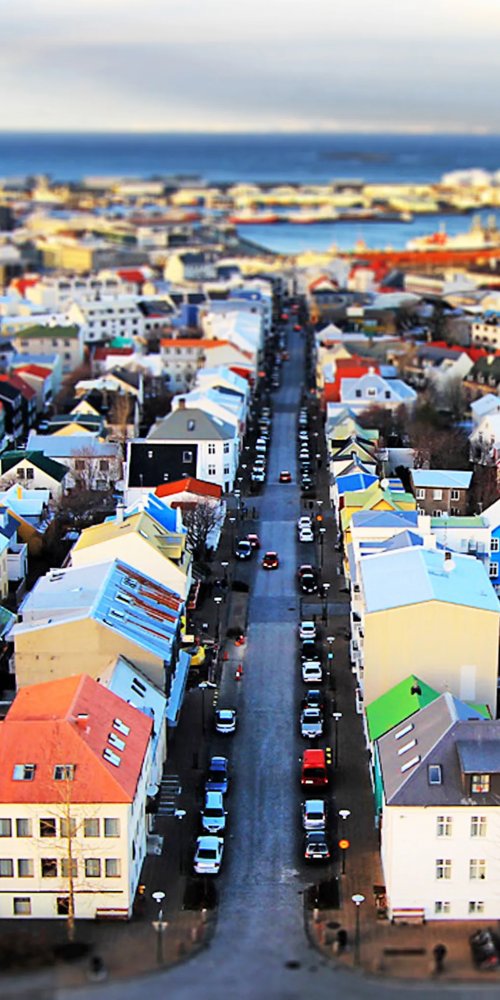
Stepping off the plane in Reykjavík, you’re greeted by a crisp Scandinavian breeze mixed with the faint aroma of salty ocean air and freshly brewed coffee from nearby cafés. The streets hum gently with life; colourful houses dot the landscape beneath the soft glow of the midnight sun or dancing northern lights, setting a surreal stage. You catch snippets of Icelandic - a melodic language that feels like a song - amidst laughter and the clink of glasses. This city, where old Vikings meet modern creativity, invites you to explore its lively streets and tranquil nature alike, promising a feast for all your senses.
Quick Facts About Reykjavík, IS
- Population & Language: Approximately 131,000 residents; official language is Icelandic, with widespread English proficiency
- Currency & Payment: Icelandic króna (ISK); credit and contactless cards widely accepted
- Best Seasons to Visit: Summer (June-August) for mild weather and extended daylight; winter (December-February) for Northern Lights and festive charm
- Airport Distance: Keflavík International Airport 50 km from downtown Reykjavík (approx. 45-minute drive)
- Transit Pass Price: Cheapest full-day Reykjavík public transport pass costs 990 ISK (~€6.50, Tourism Board, March 2025)
- Cappuccino Cost: Around 550 ISK (~€3.50) as of March 2025
Your Ride, Your Way
Simple & Trusted Car Rentals by Auro ICE Car Rental
https://auroicecarrental.com/
Why Visit Reykjavík, IS?
Reykjavík is a city that effortlessly blends rugged Nordic tradition with vibrant modern life. Whether you’re wandering through lively downtown streets humming with creativity or soaking in geothermal pools warmed by Iceland’s volcanic heart, the atmosphere is electric yet intimate. The local cafés brim with storytellers and artists, where you’ll quickly feel like part of the community over a rich cup of coffee. Reykjavík’s reputation as a cultural hub has blossomed in recent years, with ever more festivals, galleries and quirky shops tumbling into the spotlight - all set against breathtaking natural backdrops just minutes away. I remember the first time I climbed the Hallgrímskirkja cathedral tower; the panoramic views over rooftops cascading towards the sea made every step worthwhile. In Reykjavík, the unexpected lies around every corner, making every visit an adventure and every street a path to new stories.
Top 10 Must-See Sights in Reykjavík, IS
- Hallgrímskirkja Church: This iconic landmark dominates the skyline with its striking, modernist architecture inspired by Iceland’s basalt columns. Climb to the tower for panoramic views that capture Reykjavík’s charm and the surrounding mountains.
- Harpa Concert Hall: A glass marvel sitting by the old harbour, Harpa dazzles with its kaleidoscopic facade. Experience a concert or simply explore the building’s design - it’s one of the top attractions Reykjavík, IS offers to design lovers.
- Old Harbour: Bustling with fishing vessels, whale-watching tours, and vibrant eateries, the harbour is a gateway to the sea and culinary treats. Try fresh seafood while watching boats bobbing in the bay.
- National Museum of Iceland: Discover centuries of Icelandic history through engaging exhibits, including Viking relics and contemporary cultural highlights. It’s a must for understanding the roots beneath modern Reykjavík.
- Sun Voyager (Sólfar) Sculpture: This striking steel sculpture embodies the spirit of exploration and adventure. Sitting on the waterfront, it’s a favourite spot for sunset views and reflective pauses.
- Perlan (The Pearl): A futuristic glass dome housing a planetarium, restaurant, and an artificial ice cave. The observation deck offers sweeping city and nature views - a unique way to see Reykjavík, IS from above.
- Laugavegur Street: The city’s main shopping artery pulses with boutiques, art galleries, bars and cafés. It’s the perfect place to soak up local life and pick up Icelandic design goods.
- Reykjavík Maritime Museum: Dive into the nation’s seafaring heritage with interactive displays and authentic vessels. Ideal for families or history buffs exploring the coastal side of the city.
- Videy Island: Just a short ferry ride away, Videy offers peaceful walking trails, sculptures and remarkable birdwatching opportunities - perfect for escaping the city bustle without going far.
- Imagine Peace Tower: A luminous beacon dedicated to peace, lit every year on John Lennon’s birthday. It’s a poignant emblem of Reykjavík’s global cultural connections and idealism.
Reykjavík - Recommended Companies
Price & Time Grid: Attractions at a Glance
| Attraction | Adult Ticket (€) | Average Visit Time | Skip-the-Line Option | Nearest Metro Stop |
|---|---|---|---|---|
| Hallgrímskirkja Church | Free (tower €7) | 1 hr | Yes (tower) | Central Bus |
| Harpa Concert Hall | Free entry | 30 min | – | Central Bus |
| Old Harbour | Free | 1–2 hrs | Not applicable | Central Bus |
| National Museum of Iceland | €15 | 1.5–2 hrs | Yes | Central Bus |
| Sun Voyager | Free | 20 min | – | Central Bus |
| Perlan | €20 (observation) | 1–1.5 hrs | Yes | Central Bus |
| Laugavegur Street | Free | Variable | Not applicable | Central Bus |
| Reykjavík Maritime Museum | €10 | 1 hr | Yes | Central Bus |
| Videy Island | Ferry €8 | 2–3 hrs | No | Central Bus |
| Imagine Peace Tower | Free | 20 min | – | Central Bus |
While Reykjavík, IS offers a compact centre with most sights clustered around downtown, planning your days with ticket timings and skip-the-line options can save valuable moments. The tickets remain affordable by European standards, reflecting excellent value for unique cultural experiences - especially when visiting popular destinations in Reykjavík, IS that draw large crowds during the high season.
Neighbourhood Snapshots
Downtown Reykjavík (Miðborg)
Downtown is the city’s vibrant heart, where colourful small houses sit cheek by jowl with modern glass-fronted buildings. Here you’ll find the best cafés, shops and galleries buzzing with life, especially around Laugavegur Street. It’s a lively mix of historic charm and urban energy - perfect for wandering with no set agenda.
Vesturbær
West of the city centre, Vesturbær offers a cozier, quieter neighbourhood feel with leafy streets and seaside vistas. It’s dotted with small parks, local eateries and walking routes along the coast. When I stayed here, breakfast overlooking the ocean became a daily treat.
Hlíðar and Háaleiti
These residential districts offer insight into everyday Icelandic life, with relaxed cafés, markets, and urban farms. They’re ideal for travellers wanting a break from tourist hubs while still being a short transit ride away from top attractions Reykjavík, IS is known for.
Old Harbour Area
The Old Harbour blends working fishing ports with trendy restaurants and galleries. It’s an atmospheric neighbourhood perfect for fresh seafood dinners, whale watching tours, and watching the city life from the water’s edge.
Hidden Gems & Local Culture
- Árbæjarsafn Open-Air Museum: A hands-on museum set among traditional Icelandic houses that showcase rural life.
- Grótta Lighthouse: Located on a small peninsula west of the city centre, perfect for birdwatching and viewing Northern Lights away from city light pollution.
- Kaffibrennslan Café: A local favourite for coffee lovers, offering meticulously brewed single-origin beans and a welcoming atmosphere off the tourist trail.
Getting Around the City
While Reykjavík does not have a metro or tram system, its well-connected bus network covers the city thoroughly. Buses run frequently and connect you to all major sights - grab a travel pass for ease.
Trams and metro projects have been discussed but remain in planning stages. Meanwhile, the city's compactness invites walking; many popular destinations in Reykjavík, IS are within a comfortable distance on foot.
For the more eco-conscious traveller, the city offers a reliable bike-share scheme that is both affordable and practical during the long summer days. Cycling is enjoyable, with dedicated lanes and safe routes, especially in the flat downtown area.
Taxi services are available but pricier, so plan accordingly if visiting late or with heavy luggage. Many visitors prefer combining walking with occasional bus rides to maximise time and budget for things to do in Reykjavík, IS.

Money-Saving Tips
- Buy a Reykjavík City Card for free entry to museums and free public transport (Tourism Board, 2025).
- Visit popular destinations in Reykjavík, IS early or late to avoid peak prices and crowds.
- Choose cafés off main streets for better coffee prices without sacrificing quality.
- Book tours and experiences online in advance for discounted rates.
- Use grocery stores and markets for snacks, saving money on meals between sightseeing.
Sample 3-Day Reykjavík, IS Itinerary
- Day 1: Explore Hallgrímskirkja church and climb the tower for morning views; wander Laugavegur street for lunch and shopping; afternoon at Harpa Concert Hall and Old Harbour.
- Day 2: Visit the National Museum of Iceland; relax at Perlan, exploring the ice cave and observation deck; evening walk to Sun Voyager sculpture for sunset.
- Day 3: Take ferry to Videy Island for nature and art; visit Reykjavík Maritime Museum in the afternoon; finish with a peaceful moment at Imagine Peace Tower.
Your Ride, Your Way
Simple & Trusted Car Rentals by Auro ICE Car Rental
https://auroicecarrental.com/
Eight Mistakes Travellers Make in Reykjavík, IS
- Underestimating weather changes - always pack layers, even in summer.
- Trying to see everything in one day, missing the city’s relaxed pace.
- Ignoring local Icelandic phrases; a simple “takk” (thank you) goes far.
- Not validating a transit card before boarding buses, causing delays.
- Skipping out on local seafood, missing a core part of Icelandic culture.
- Booking tours last-minute in high season, leading to sold-out experiences.
- Focusing only on downtown and missing out on quieter districts’ charm.
- Failing to recycle properly - Reykjavik is eco-conscious and expects visitors to respect this.
Frequently Asked Questions
When is the best time to visit Reykjavík for Northern Lights?
The Northern Lights are most visible from late September to mid-April. Clear, dark skies away from city lights increase your chances, so plan a few nights outside peak light pollution.
What currency should I use and can I rely on cards?
Icelandic króna (ISK) is the official currency, but credit and contactless cards are accepted nearly everywhere, making cash almost unnecessary.
How much time do I need to see the popular destinations in Reykjavík, IS?
At least three full days allows you to visit top attractions Reykjavík, IS offers comfortably, including some hidden gems and leisure time.
Is Reykjavík a walkable city?
Yes, downtown Reykjavík is compact, walkable, and pedestrian-friendly, though public transport helps for some outer areas.
Ready to Explore Reykjavík?
Now that you know the popular destinations in Reykjavík, IS and the best ways to enjoy them, your unforgettable adventure awaits. Share your experiences or questions in the comments below, and don’t forget to subscribe for more inspiring travel guides. Reykjavík’s magic is ready whenever you are!










